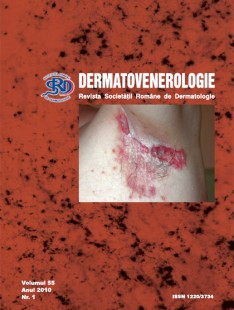Clinical trials and experimental
Quantitatively and qualitatively assess of lymphangiogenesis in malignant melanoma of the face
Background.
Cutaneous malignant melanoma is a potentially lethal neoplasm known to metastasize via lymphatic and blood vessels. New potential prognostic factors such as: tumor vascularity, vascular invasion and tumorinfiltrating lymphocytes are yet insufficiently studied. Thus, some authors focused on lymphangiogenesis in malignant melanoma of the skin and results were contradictory. In this context, the aim of our study was to qualitatively and quantitatively assess the lymphangiogenesis in cutaneous melanoma of the face, using immunohistochemical methods to emphasize the lymphatic endothelium and a computer software for the quantitative evaluation.
Material and methods.
We examined 14 formalinfixed, paraffin-embedded excision pieces of cutaneous malignant melanoma of the face. All cases were advanced primary melanomas, with an anatomical level of invasion (Clark) between III and V. Serial sections of 3 μm thickness were prepared for immunohistochemical analysis.
Lymphatic vessels were marked with D2-40 murin monoclonal antibody and examined in optic microscopy (x200) for qualitative assessment. Morphometric evaluation was made using NIS-Elements software.
Results.
Peritumoral lymphatic vessels were generally dilatedwith a thin, irregularwall andweremainly found inside the inflammatory infiltrate, next to the tumor, or in connective septa penetrating tumoral nodules. Intratumoral lymphatics were smaller, with an irregular aspect and prominent walls, some of them with very small or even collapsed lumen.
Lymphatic vessel density (LVD) was significantly higher in peritumoral areas. The relative lymphatic area (lymphatic area devided by total area of the examined field x 100) was slightly higher in peritumoral regions.
Conclusions.
Evaluation of lymphangiogenesis by determination of lymphatic vessel density, average and relative lymphatic area in cutaneous malignant melanoma may prove to be a useful tool for the assessment of melanoma progression. Further research is needed in order to clearly establish these parameters as strong prognostic indicators.


